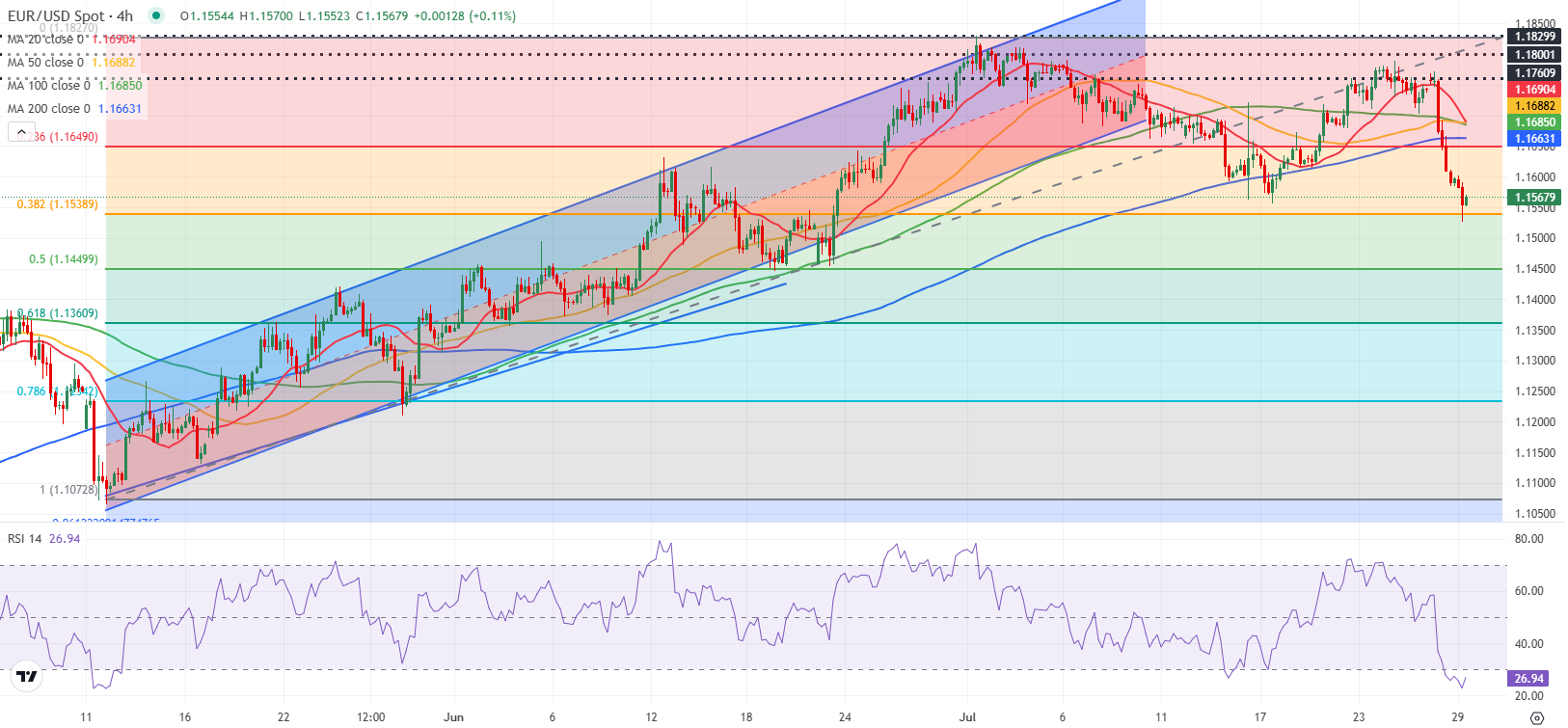
- EUR/USD trades below 1.1600 in the European session on Tuesday.
- The technical outlook points to oversold conditions in the near term.
- Markets await US data, headlines out of US-China trade talks.
EUR/USD recovers modestly from the multi-week low it set below 1.1530 but the bearish outlook remains unchanged. In the second half of the day, mid-tier data releases from the United States (US) and headlines coming out of the US-China trade negotiations will be watched closely by market participants.
Euro PRICE This week
The table below shows the percentage change of Euro (EUR) against listed major currencies this week. Euro was the weakest against the US Dollar.
| USD | EUR | GBP | JPY | CAD | AUD | NZD | CHF | |
|---|---|---|---|---|---|---|---|---|
| USD | 1.63% | 0.65% | 0.53% | 0.25% | 0.94% | 0.93% | 1.00% | |
| EUR | -1.63% | -1.00% | -1.05% | -1.37% | -0.68% | -0.70% | -0.63% | |
| GBP | -0.65% | 1.00% | -0.24% | -0.38% | 0.32% | 0.30% | 0.37% | |
| JPY | -0.53% | 1.05% | 0.24% | -0.27% | 0.36% | 0.38% | 0.61% | |
| CAD | -0.25% | 1.37% | 0.38% | 0.27% | 0.66% | 0.68% | 0.75% | |
| AUD | -0.94% | 0.68% | -0.32% | -0.36% | -0.66% | -0.02% | 0.05% | |
| NZD | -0.93% | 0.70% | -0.30% | -0.38% | -0.68% | 0.02% | 0.07% | |
| CHF | -1.00% | 0.63% | -0.37% | -0.61% | -0.75% | -0.05% | -0.07% |
The heat map shows percentage changes of major currencies against each other. The base currency is picked from the left column, while the quote currency is picked from the top row. For example, if you pick the Euro from the left column and move along the horizontal line to the US Dollar, the percentage change displayed in the box will represent EUR (base)/USD (quote).
The broad-based US Dollar (USD) strength weighed heavily on EUR/USD on Monday as investors cheered the news of a trade deal between the European Union (EU) and the US. Additionally, this development revived expectations for another 25 basis points European Central Bank (ECB) rate cut this year, making it difficult for the Euro to find demand.
On Tuesday, the US economic calendar will feature the Conference Board’s Consumer Confidence Index for July and JOLTS Job Openings data for June. Ahead of the Federal Reserve’s (Fed) monetary policy announcements on Wednesday, investors could refrain from taking large positions based on these data alone. Nevertheless, the USD could benefit from positive surprises and cause EUR/USD to stretch lower.
Reuters reported late Monday that US Treasury Secretary Scott Bessent and China’s Vice Premier He Lifeng worked to resolve “key trade and technology disputes, with China seeking relief from US tariffs and curbs on tech exports,” during talks in Stockholm. Sides will reportedly meet again on Tuesday for the next round of talks. If the US and China manage to make further progress in trade relations, the USD could preserve its strength heading into the Fed event.
EUR/USD Technical Analysis

The Relative Strength Index (RSI) indicator on the 4-hour chart stays below 30, suggesting that EUR/USD’s latest recovery attempt is a technical correction and that the bearish bias remains intact.
On the downside, 1.1540 (Fibonacci 38.2% retracement of the latest uptrend) aligns as the first support level before 1.1500 (static level, round level) and 1.1450 (Fibonacci 50% retracement). Looking north, resistance levels could be spotted at 1.1600 (round level, static level), 1.1660-1.1650 (200-period Simple Moving Average (SMA), Fibonacci 23.6% retracement) and 1.1690-1.1700 (20-day SMA, static level).
Euro FAQs
The Euro is the currency for the 19 European Union countries that belong to the Eurozone. It is the second most heavily traded currency in the world behind the US Dollar. In 2022, it accounted for 31% of all foreign exchange transactions, with an average daily turnover of over $2.2 trillion a day. EUR/USD is the most heavily traded currency pair in the world, accounting for an estimated 30% off all transactions, followed by EUR/JPY (4%), EUR/GBP (3%) and EUR/AUD (2%).
The European Central Bank (ECB) in Frankfurt, Germany, is the reserve bank for the Eurozone. The ECB sets interest rates and manages monetary policy. The ECB’s primary mandate is to maintain price stability, which means either controlling inflation or stimulating growth. Its primary tool is the raising or lowering of interest rates. Relatively high interest rates – or the expectation of higher rates – will usually benefit the Euro and vice versa. The ECB Governing Council makes monetary policy decisions at meetings held eight times a year. Decisions are made by heads of the Eurozone national banks and six permanent members, including the President of the ECB, Christine Lagarde.
Eurozone inflation data, measured by the Harmonized Index of Consumer Prices (HICP), is an important econometric for the Euro. If inflation rises more than expected, especially if above the ECB’s 2% target, it obliges the ECB to raise interest rates to bring it back under control. Relatively high interest rates compared to its counterparts will usually benefit the Euro, as it makes the region more attractive as a place for global investors to park their money.
Data releases gauge the health of the economy and can impact on the Euro. Indicators such as GDP, Manufacturing and Services PMIs, employment, and consumer sentiment surveys can all influence the direction of the single currency. A strong economy is good for the Euro. Not only does it attract more foreign investment but it may encourage the ECB to put up interest rates, which will directly strengthen the Euro. Otherwise, if economic data is weak, the Euro is likely to fall. Economic data for the four largest economies in the euro area (Germany, France, Italy and Spain) are especially significant, as they account for 75% of the Eurozone’s economy.
Another significant data release for the Euro is the Trade Balance. This indicator measures the difference between what a country earns from its exports and what it spends on imports over a given period. If a country produces highly sought after exports then its currency will gain in value purely from the extra demand created from foreign buyers seeking to purchase these goods. Therefore, a positive net Trade Balance strengthens a currency and vice versa for a negative balance.
Information on these pages contains forward-looking statements that involve risks and uncertainties. Markets and instruments profiled on this page are for informational purposes only and should not in any way come across as a recommendation to buy or sell in these assets. You should do your own thorough research before making any investment decisions. FXStreet does not in any way guarantee that this information is free from mistakes, errors, or material misstatements. It also does not guarantee that this information is of a timely nature. Investing in Open Markets involves a great deal of risk, including the loss of all or a portion of your investment, as well as emotional distress. All risks, losses and costs associated with investing, including total loss of principal, are your responsibility. The views and opinions expressed in this article are those of the authors and do not necessarily reflect the official policy or position of FXStreet nor its advertisers. The author will not be held responsible for information that is found at the end of links posted on this page.
If not otherwise explicitly mentioned in the body of the article, at the time of writing, the author has no position in any stock mentioned in this article and no business relationship with any company mentioned. The author has not received compensation for writing this article, other than from FXStreet.
FXStreet and the author do not provide personalized recommendations. The author makes no representations as to the accuracy, completeness, or suitability of this information. FXStreet and the author will not be liable for any errors, omissions or any losses, injuries or damages arising from this information and its display or use. Errors and omissions excepted.
The author and FXStreet are not registered investment advisors and nothing in this article is intended to be investment advice.







